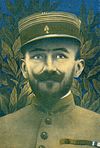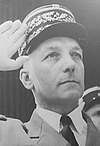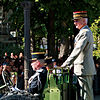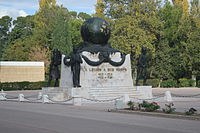French Foreign Legion
The French Foreign Legion (French: Légion étrangère) is an elite corps of the French Army that consists of several specialties: infantry, cavalry, engineers, airborne troops.[8] It was created in 1831 to allow foreign nationals into the French Army.[9] It formed part of the Armée d’Afrique, the French Army's units associated with France's colonial project in Northern Africa, until the end of the Algerian War in 1962.[10]
Legionnaires are highly trained soldiers and the Legion is unique in that it is open to foreign recruits willing to serve in the French Armed Forces. The Legion is known today as a unit whose training focuses on traditional military skills and on its strong esprit de corps, as its men come from different countries with different cultures. Consequently, training is often described as not only physically challenging, but also very stressful psychologically. Legionnaires may apply for French citizenship after three years' service, or immediately after being wounded during a battle for France under a provision known as "Français par le sang versé" ("French by spilled blood").[11]
History[edit]
The Foreign Legion was created by Louis Philippe,[12] the King of the French, on 10 March 1831 to allow the incorporation of foreign nationals into the French Army from the foreign regiments of the Kingdom of France.[13] Recruits included soldiers from the recently disbanded Swiss and German foreign regiments of the Bourbon monarchy.[14] The Royal Ordinance for the establishment of the new regiment specified that the foreigners recruited could only serve outside France.[15] The French expeditionary force that had occupied Algiers in 1830 was in need of reinforcements and the Legion was accordingly transferred by sea in detachments from Toulon to Algeria.[11][16] Since 1831, the Legion has consisted of hundreds of thousands in active service at its peak, and suffered the aggregated loss of nearly 40,000 men[17] in France, Algeria, Morocco, Tunisia, Madagascar, West Africa, Mexico, Italy, Crimea, Spain, Indo-China, Norway, Syria, Chad, Zaïre, Lebanon, Central Africa, Gabon, Kuwait, Rwanda, Djibouti, former Yugoslavia, Somalia, the Republic of Congo, Ivory Coast, Afghanistan, Mali, as well as others. The Legion was primarily used to help protect and expand the French colonial empire during the 19th century. The Foreign Legion was initially stationed only in Algeria, where it took part in the pacification and development of the colony. Subsequently, the Foreign Legion was deployed in a number of conflicts, including the First Carlist War in 1835, the Crimean War in 1854, the Second Italian War of Independence in 1859, the French intervention in Mexico in 1863, the Franco-Prussian War in 1870, the Tonkin Campaign and Sino-French War in 1883, supporting growth of the French colonial empire in Sub-Saharan Africa, the Second Franco-Dahomean War in 1892, the Second Madagascar expedition in 1895 and the Mandingo Wars in 1894. In World War I, the Foreign Legion fought in many critical battles on the Western Front. It played a smaller role in World War II than in World War I, though having a part in the Norwegian, Syrian and North African campaigns. During the First Indochina War (1946–1954), the Foreign Legion saw its numbers swell. The Legion lost a large number of men in the catastrophic Battle of Dien Bien Phu against forces of the Viet Minh.
Subsequent military campaigns included those during the Suez Crisis, the Battle of Algiers and various offensives in Algeria launched by General Maurice Challe including Operation Oranie and Operation Jumelles. During the Algerian War of Independence (1954–1962), the Foreign Legion came close to being disbanded after some officers, men, and the highly decorated 1st Foreign Parachute Regiment (1er REP) took part in the Generals' putsch. In the 1960s and 1970s, Legion regiments had additional roles in sending units as a rapid deployment force to preserve French interests – in its former African colonies and in other nations as well; it also returned to its roots of being a unit always ready to be sent to conflict zones around the world.
Some notable operations include the Chadian–Libyan conflict in 1969–1972 (the first time that the Legion was sent in operations after the Algerian War), 1978–1979, and 1983–1987; Kolwezi in what is now the Democratic Republic of the Congo in May 1978. In 1981, the 1st Foreign Regiment and Foreign Legion regiments took part in the Multinational Force in Lebanon. In 1990, Foreign Legion regiments were sent to the Persian Gulf and participated in Opération Daguet, part of Division Daguet. Following the Gulf War in the 1990s, the Foreign Legion helped with the evacuation of French citizens and foreigners in Rwanda, Gabon and Zaire. The Foreign Legion was also deployed in Cambodia, Somalia, Sarajevo, Bosnia and Herzegovina. In the mid- to late 1990s, the Foreign Legion was deployed in the Central African Republic, Congo-Brazzaville and in Kosovo. The French Foreign Legion also took part in operations in Rwanda in 1990–1994; and the Ivory Coast in 2002 to the present. In the 2000s, the Foreign Legion was deployed in Operation Enduring Freedom in Afghanistan, Opération Licorne in Ivory Coast, the EUFOR Tchad/RCA in Chad, and Operation Serval in the Northern Mali conflict.[18]
As discussed below, other countries have tried to emulate the French Foreign Legion model. The Foreign Legion was primarily used, as part of the Armée d'Afrique, to protect and expand the French colonial empire during the 19th century, but it also fought in almost all French wars including the Franco-Prussian War, World War I and World War II. The Foreign Legion has remained an important part of the French Army and sea transport protected by the French Navy, surviving three Republics, the Second French Empire, two World Wars, the rise and fall of mass conscript armies, the dismantling of the French colonial empire, and the loss of the Foreign Legion's base, Algeria.
Traditions[edit]
As the Foreign Legion is composed of soldiers of different nationalities and backgrounds, it is necessary to develop an intense esprit de corps,[46] which is achieved through the development of camaraderie,[46] specific traditions, the loyalty of its legionnaires, the quality of their training, and the pride of being a soldier in an elite unit.[46]
Code of honour[edit]
The "Legionnaire's Code of Honour"[72][73] is the Legion's creed, recited in French only.[74][75] The Code of Honour was adopted in the 1980s.[72]
| Code d'honneur du légionnaire | Legionnaire's Code of Honour | |
|---|---|---|
| Art. 1 | Légionnaire, tu es un volontaire, servant la France avec honneur et fidélité. | Legionnaire, you are a volunteer serving France with honour and loyalty. |
| Art. 2 | Chaque légionnaire est ton frère d'armes, quelle que soit sa nationalité, sa race ou sa religion. Tu lui manifestes toujours la solidarité étroite qui doit unir les membres d'une même famille. | Each legionnaire is your brother in arms whatever his nationality, his race or his religion might be. You show him the same close solidarity that links the members of the same family. |
| Art. 3 | Respectueux des traditions, attaché à tes chefs, la discipline et la camaraderie sont ta force, le courage et la loyauté tes vertus. | Respect for traditions, devotion to your leaders, discipline and comradeship are your strengths, courage and loyalty your virtues. |
| Art. 4 | Fier de ton état de légionnaire, tu le montres dans ta tenue toujours élégante, ton comportement toujours digne mais modeste, ton casernement toujours net. | Proud of your status as legionnaire, you display this in your always impeccable uniform, your always dignified but modest behaviour, and your clean living quarters. |
| Art. 5 | Soldat d'élite, tu t’entraînes avec rigueur, tu entretiens ton arme comme ton bien le plus précieux, tu as le souci constant de ta forme physique. | An elite soldier, you train rigorously, you maintain your weapon as your most precious possession, and you take constant care of your physical form. |
| Art. 6 | La mission est sacrée, tu l'exécutes jusqu’au bout et, s'il le faut, en opérations, au péril de ta vie. | The mission is sacred, you carry it out until the end and, if necessary in the field, at the risk of your life. |
| Art. 7 | Au combat, tu agis sans passion et sans haine, tu respectes les ennemis vaincus, tu n’abandonnes jamais ni tes morts, ni tes blessés, ni tes armes. | In combat, you act without passion and without hate, you respect defeated enemies, and you never abandon neither your dead, nor your wounded, nor your arms. |
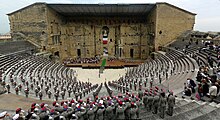

Mottos[edit]
Honneur et Fidélité[edit]
In contrast to all other French Army units, the motto embroidered on the Foreign Legion's regimental flags is not Honneur et Patrie (Honour and Fatherland) but Honneur et Fidélité (Honour and Fidelity).[76]
Legio Patria Nostra[edit]
Legio Patria Nostra (in French La Légion est notre Patrie, in English The Legion is our Fatherland) is the Latin motto of the Foreign Legion.[76] The adoption of the Foreign Legion as a new "Fatherland" does not imply the repudiation by the legionnaire of his original nationality. The Foreign Legion is required to obtain the agreement of any legionnaire before he is placed in any situation where he might have to serve against his country of birth.
Regimental mottos[edit]
- 1er R.E: Honneur et Fidélité
- G.R.L.E: Honneur et Fidélité
- 1er REC: Honneur et Fidélité and Nec Pluribus Impar (No other equal)
- 2e REP: Honneur et Fidélité and More Majorum[77] (in the manner, ways and traditions of our veterans[78] foreign regiments)
- 2e REI: Honneur et Fidélité and Être prêt (Be ready)
- 2e REG: Honneur et Fidélité and Rien n'empêche (Nothing prevents)
- 3e REI: Honneur et Fidélité and Legio Patria Nostra
- 4e R.E: Honneur et Fidélité and Creuset de la Légion et Régiment des fortes têtes (The crucible of the Legion and the strong right minded regiment)
- 1e REG: Honneur et Fidélité and Ad Unum (All to one end – for the regiment until the last one)
- 13e DBLE: Honneur et Fidélité and More Majorum[77] ("in the manner, ways and traditions of our veterans foreign regiments")
- DLEM: Honneur et Fidélité and Pericula Ludus (Dangers game – for the regiment To Danger is my pleasure of the 2nd Foreign Cavalry Regiment)
Insignia[edit]
Ranks[edit]
All volunteers in the Foreign Legion begin their careers as basic legionnaires with one in four eventually becoming a sous-officier (non-commissioned officer).[81] On joining, a new recruit receives a monthly salary of €1,380 in addition to food and lodgings.[82] He is also given his own new rifle, which according to the lore of the Legion must never be left on a battlefield.[11] Promotion is concurrent with the ranks in the French Army.

| Foreign Legion rank | Equivalent rank | NATO Code | Period of service | Insignia |
|---|---|---|---|---|
| Engagé Volontaire | Recruit | – | 15 weeks basic training. | None |
| Legionnaire 2e Classe | Private / 2nd Class Legionnaire | OR-1 | Promoted after completion of training and Marche képi blanc (White Kepi march). | None |
| Legionnaire 1e Classe | Private / 1st Class Legionnaire | OR-2 | Promoted after ten months of service. | |
| Caporal | Corporal | OR-3 | Promotion possible after one year of service and completion of the Fonctionnaire Caporal (or Caporal "Fut Fut") course. Recruits selected for this course need to show good leadership skills during basic training. | |
| Caporal-Chef | Senior Corporal | OR-4 | Promotion after six years of service. | |
| Table note: Command insignia in the Foreign Legion use gold lace or braid indicating infantry troops in the French Army. The Légion étrangère service color is green (for the now-defunct colonial Armée d'Afrique) instead of red (regular infantry). | ||||
Non-commissioned and warrant officers[edit]

A dress uniform's insignia is composed of three components; rank emblem, regimental patch, and seniority chevrons. In the one pictured, the three upward pointing gold chevrons indicate a Sergent-chef. The diamond-shaped regimental patch (Écusson) is formed of three green diamond shapes surrounding a grenade emblem, with the three diamonds indicating a Colonial unit, in comparison to one diamond for a unit of Regulars, or two diamonds for a Reserves unit. The Légion grenade emblem has seven flames rather than the usual five, and the two downward pointing seniority chevrons indicate at least 10 years of service. Some Caporals-Chef may have as many as six seniority chevrons for 30 or more years of service. This style of insignia is worn only on the left sleeve of the dress uniform, while a similar-sized insignia without the regimental diamond and seniority chevrons is worn on the right sleeve. An exception exists for the right sleeve insignia for the Pioneer units, which incorporates a gold or green Pioneer emblem, depending on rank, but not the seniority chevrons, which are worn on the left sleeve insignia below the regimental diamond as previously described.
Sous-officiers (NCOs) including warrant officers account for 25% of the current Foreign Legion's total manpower.
| Foreign Legion rank | Equivalent rank | NATO Code | Period of service | Insignia |
|---|---|---|---|---|
| Sergent | Sergeant | OR-5 | Promotion after three years of service as Caporal. | |
| Sergent-Chef | Senior Sergeant | OR-6 | Promotion after three years as Sergent and from seven to fourteen years of service. | |
| Adjudant | Warrant Officer | OR-8 | Promotion after three years as Sergent-Chef. | |
| Adjudant-Chef[a] | Chief Warrant Officer | OR-9 | Promotion after four years as Adjudant and at least fourteen years of service. | |
| Major[b] | Major[84] | OR-9 | Promotion after either passing an examination or without an examination after a minimum of fourteen years service. | |
| ||||
Commissioned officers[edit]
Most officers are regulars of the French Army though roughly 10% are former non-commissioned officers promoted from the ranks.[81]
| Foreign Legion rank | Equivalent rank | NATO Code | Command responsibility | Insignia |
|---|---|---|---|---|
| Aspirant | Officer Designate | OF-D | Officer Designate. Technically it is not a commissioned rank but it is still treated in all respects as one. Aspirants are either officers in training or volunteers serving as temporary officers. S/He may afterwards apply to obtain permanent commissioned status as a Sous-lieutenant.[85] |  |
| Sous-Lieutenant | Second lieutenant | OF-1 | Junior section leader | |
| Lieutenant | First lieutenant | OF-1 | Platoon commander | |
| Capitaine | Captain | OF-2 | Company commander | |
| Commandant | Major | OF-3 | Battalion commander | |
| Lieutenant-Colonel | Lieutenant colonel | OF-4 | Junior commander of a régiment or demi-brigade | |
| Colonel | Colonel | OF-5 | Régiment or demi-brigade commander | |
| Général de brigade | Brigadier general | OF-6 | Commander of a brigade composed of régiments or demi-brigades. | |
| Général de division | Divisional general | OF-7 | Entire division or Army Corps of the French Foreign Legion (Commandement de la Légion étrangère)[86] |
Seniority chevrons[edit]
The Foreign Legion uses gold coloured chevrons (chevrons d'ancienneté) pointed downward to indicate seniority. Worn by ordinary legionnaires and non-commissioned officers beneath the rank insignia and regimental emblem only on the left sleeve of the dress uniform,[87] each chevron denotes five years of service in the Legion. Seniority chevrons are not worn by commissioned officers.
Honorary ranks[edit]
Honorary ranks have been awarded by the French Army to individuals credited with exceptional acts of courage since 1796. In the Foreign Legion, General Paul-Frédéric Rollet introduced the practice of awarding honorary Legion ranks to distinguished individuals, both civilian and military, in the early 20th century.
Recipients of these honorary appointments had participated with units of the Legion on active service in an exemplary manner, or had rendered exceptional service to the Legion in non-combat situations.[88] More than 1,200 individuals have been granted honorary ranks in the Legion pour services éminent. The majority of these awards have been made to military personnel in wartime, earning titles such as Legionnaire d'Honneur or Sergent-Chef de Légion d'honneur, while other recipients have included nurses, journalists, painters, and ministers who have rendered meritorious service to the Foreign Legion.[88]
Pioneers[edit]

The Pionniers (pioneers) are the combat engineers and a traditional unit of the Foreign Legion. The sapper traditionally sport large beards, wear leather aprons and gloves and hold axes. The sappers were very common in European armies during the Napoleonic Era but progressively disappeared during the 19th century. The French Army, including the Legion disbanded its regimental sapper platoons in 1870. However, in 1931 one of a number of traditions restored to mark the hundredth anniversary of the Legion's founding was the reestablishment of its bearded Pionniers.[89]
In the French Army, since the 18th century, every infantry regiment included a small detachment of pioneers. In addition to undertaking road building and entrenchment work, such units were tasked with using their axes and shovels to clear obstacles under enemy fire opening the way for the rest of the infantry. The danger of such missions was recognised by allowing certain privileges, such as being authorised to wear beards.
The current pioneer platoon of the Foreign Legion is provided by the Legion depot and headquarters regiment for public ceremonies.[90] The unit has reintroduced the symbols of the Napoleonic sappers: the beard, the axe, the leather apron, the crossed-axes insignia and the leather gloves. When parades of the Foreign Legion are opened by this unit, it is to commemorate the traditional role of the sappers "opening the way" for the troops.[89]
Marching cadences and songs[edit]

Also notable is the marching pace of the Foreign Legion. In comparison to the 116-step-per-minute pace of other French units, the Foreign Legion has an 88-step-per-minute marching speed. It is also referred to by Legionnaires as the "crawl". This can be seen at ceremonial parades and public displays attended by the Foreign Legion, particularly while parading in Paris on 14 July (Bastille Day Military Parade). Because of the impressively slow pace, the Foreign Legion is always the last unit marching in any parade. The Foreign Legion is normally accompanied by its own band, which traditionally plays the march of any one of the Foreign Legion's regiments, except that of the unit actually on parade. The regimental song of each unit and "Le Boudin" is sung by legionnaires standing at attention. Also, because the Foreign Legion must always stay together, it does not break formation into two when approaching the presidential grandstand, as other French military units do, in order to preserve the unity of the legion.
Contrary to popular belief, the adoption of the Foreign Legion's slow marching speed was not due to a need to preserve energy and fluids during long marches under the hot Algerian sun. Its exact origins are unclear, but the official explanation is that although the pace regulation does not seem to have been instituted before 1945, it hails back to the slow marching pace of the Ancien Régime, and its reintroduction was a "return to traditional roots".[91] This was in fact, the march step of the Foreign Legion's ancestor units – the Régiments Étrangers or Foreign Regiments of the Ancien Régime French Army, the Grande Armée's foreign units, and the pre-1831 foreign regiments.
Marching songs[edit]
"Le Boudin"[edit]

"Le Boudin"[5][92] is the marching song of the Foreign Legion.
Other songs[edit]
- "Non, Je Ne Regrette Rien", 1st Foreign Parachute Regiment
- "Sous Le Ciel de Paris", The Choir of the French Foreign Legion
- "Anne Marie du 3e" REI (in German)[93]
- "Adieu, adieu"
- "Aux légionnaires"
- "Anne Marie du 2e REI"[94]
- "Adieu vieille Europe [fr]"
- "Chant de l'Oignon"
- "Chant du quatrième escadron"
- "Chez nous au 3e"
- "C'est le 4"
- "Connaissez-vous ces hommes"
- "Contre les Viêts" (song of the 13th Demi-Brigade of the Foreign Legion after having been the marching song adopted by the 1st Foreign Parachute Regiment)
- "Cravate verte et Képi blanc"
- "Dans la brume, la rocaille"
- "Défilé du 3e REI"
- "C'était un Edelweiss"
- "Écho"
- "En Afrique"
- "En Algérie" (1er RE)[95]
- "Es steht eine Mühle" (in German)
- "Eugénie"
- "Les Képis Blancs" (1e RE)[96]
- "Honneur, Fidélité"
- "Ich hatt' einen Kameraden" (in German)
- "Il est un moulin"
- "J'avais un camarade"
- "Kameraden (in German)"
- "La colonne" (1er REC)
- "La Légion marche" (2e REP)[48]
- "La lune est claire"
- "Le Caïd"
- "Le Chant Des Marais [fr]"
- "Il y a des cailloux sur toutes les routes"
- "Le fanion de la Légion"
- "Le Soleil brille"
- "Le front haut et l'âme fière" (5e RE)
- "Légionnaire de l'Afrique"
- "Massari Marie [fr]"
- "Monica"
- "Sous le Soleil brûlant d'Afrique" (13e DBLE)
- "Nous sommes tous des volontaires" (1er RE)[97]
- "Nous sommes de la Légion"
- "La petite piste"
- "Pour faire un vrai légionnaire"
- "Premier chant du 1er REC"
- "Quand on an une fille dans l'cuir"
- "Rien n'empêche" (2er REG)[98]
- "Sapeur, mineurs et bâtisseurs" (6e REG)
- "Soldats de la Légion étrangère"
- "Souvenirs qui passe"
- "Suzanna"
- "The Windmill"
- "Venu volontaire"
- "Véronica"
Uniform[edit]
From its foundation until World War I the Foreign Legion normally wore the uniform of the French line infantry for parade with a few special distinctions.[99] Essentially this consisted of a dark blue coat (later tunic) worn with red trousers. The field uniform was often modified under the influence of the extremes of climate and terrain in which the Foreign Legion served. Shakos were soon replaced by the light cloth kepi, which was far more suitable for North African conditions. The practice of wearing heavy capotes (greatcoats) on the march and vestes (short hip-length jackets) as working dress in barracks was followed by the Foreign Legion from its establishment.[100] One short lived aberration was the wearing of green uniforms in 1856 by Foreign Legion units recruited in Switzerland for service in the Crimean War.[101] In the Crimea itself (1854–59) a hooded coat and red or blue waist sashes were adopted for winter dress,[102] while during the Mexican Intervention (1863–65) straw hats or sombreros were sometimes substituted for the kepi.[103][104] When the latter was worn it was usually covered with a white "havelock" (linen cover) – the predecessor of the white kepi that was to become a symbol of the Foreign Legion. Foreign Legion units serving in France during the Franco-Prussian War of 1870–71 were distinguishable only by minor details of insignia from the bulk of the French infantry. However subsequent colonial campaigns saw an increasing use of special garments for hot weather wear such as collarless keo blouses in Tonkin 1884–85, khaki drill jackets in Dahomey (1892)[105] and drab covered topees worn with all-white fatigue dress in Madagascar[106] (1895).[107]

In the early 20th century the legionnaire wore a red kepi with blue band and piping, dark blue tunic with red collar, red cuff patches, and red trousers.[108] Distinctive features were the green epaulettes (replacing the red of the line) worn with red woollen fringes;[109] plus the embroidered Legion badge of a red flaming grenade, worn on the kepi front instead of a regimental number.[110] In the field a light khaki cover was worn over the kepi, sometimes with a protective neck curtain attached. The standard medium-blue double breasted greatcoat (capote) of the French infantry was worn, usually buttoned back to free the legs for marching.[111] From the 1830s the legionnaires had worn a broad blue woollen sash around the waist,[112] like other European units of the French Army of Africa (such as the Zouaves or the Chasseurs d'Afrique), while indigenous units of the Army of Africa (spahis and tirailleurs) wore red sashes. White linen trousers tucked into short leather leggings were substituted for red serge in hot weather.[113] This was the origin of the "Beau Geste" image.
In barracks a white bleached kepi cover was often worn together with a short dark blue jacket ("veste") or white blouse plus white trousers. The original kepi cover was khaki and due to constant washing turned white quickly. The white or khaki kepi cover was not unique to the Foreign Legion at this stage but was commonly seen amongst other French units in North Africa. It later became particularly identified with the Foreign Legion as the unit most likely to serve at remote frontier posts (other than locally recruited tirailleurs who wore fezzes or turbans). The variances of climate in North Africa led the French Army to the sensible expedient of letting local commanders decide on the appropriate "tenue de jour" (uniform of the day) according to circumstances. Thus a legionnaire might parade or walk out in blue tunic and white trousers in hot weather, blue tunic and red trousers in normal temperatures or wear the blue greatcoat with red trousers under colder conditions. The sash could be worn with greatcoat, blouse or veste but not with the tunic. Epaulettes were a detachable dress item worn only with tunic or greatcoat for parade or off duty wear.[114]

Officers wore the same dark blue (almost black) tunics as those of their colleagues in the French line regiments, except that black replaced red as a facing colour on collar and cuffs.[115] Gold fringed epaulettes were worn for full dress and rank was shown by the number of gold rings on both kepi and cuffs. Trousers were red with black stripes or white according to occasion or conditions. All-white or light khaki uniforms (from as early as the 1890s) were often worn in the field or for ordinary duties in barracks.[116] Non-commissioned officers were distinguished by red or gold diagonal stripes on the lower sleeves of tunics, vestes and greatcoats.[117] Small detachable stripes were buttoned on to the front of the white shirt-like blouse.
Prior to 1914 units in Indo-China wore white or khaki Colonial Infantry uniforms with Foreign Legion insignia, to overcome supply difficulties.[118] This dress included a white sun helmet of a model that was also issued to Foreign Legion units serving in the outposts of Southern Algeria, though never popular with its wearers.[119] During the initial months of World War I, Foreign Legion units serving in France wore the standard blue greatcoat and red trousers of the French line infantry, distinguished only by collar patches of the same blue as the capote, instead of red.[120] After a short period in sky-blue the Foreign Legion adopted khaki, in common with other units of the Armée d'Afrique, with steel helmets, from early 1916.[121][122] A mustard shade of khaki drill had been worn on active service in Morocco from 1909, replacing the classic blue and white.[123] The latter continued to be worn in the relatively peaceful conditions of Algeria throughout World War I, although increasingly replaced by khaki drill. The pre-1914 blue and red uniforms could still be occasionally seen as garrison dress in Algeria until stocks were used up about 1919.
During the early 1920s plain khaki drill uniforms of a standard pattern became universal issue for the Foreign Legion with only the red and blue kepi (with or without a cover) and green collar braiding to distinguish the Legionnaire from other French soldiers serving in North African and Indo-China. The neck curtain ceased to be worn from about 1915, although it survived in the newly raised Foreign Legion Cavalry Regiment into the 1920s. The white blouse (bourgeron) and trousers dating from 1882 were retained for fatigue wear until the 1930s.[124]
At the time of the Foreign Legion's centennial in 1931, a number of traditional features were reintroduced at the initiative of the then commander Colonel Rollet.[125] These included the blue sash and green/red epaulettes. In 1939 the white covered kepi won recognition as the official headdress of the Foreign Legion to be worn on most occasions, rather than simply as a means of reflecting heat and protecting the blue and red material underneath. The Third Foreign Infantry Regiment adopted white tunics and trousers for walking-out dress during the 1930s[126] and all Foreign Legion officers were required to obtain full dress uniforms in the pre-war colours of black and red from 1932 to 1939.
During World War II the Foreign Legion wore a wide range of uniform styles depending on supply sources. These ranged from the heavy capotes and Adrian helmets of 1940 through to British battledress and American field uniforms from 1943 to 1945. The white kepi was stubbornly retained whenever possible.
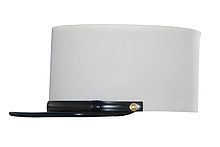
From 1940 until 1963 the Foreign Legion maintained four Saharan Companies (Compagnies Sahariennes) as part of the French forces used to patrol and police the desert regions to the south of Morocco and Algeria. Special uniforms were developed for these units, modeled on those of the French officered Camel Corps (Méharistes) having prime responsibility for the Sahara. In full dress these included black or white zouave style trousers, worn with white tunics and long flowing cloaks. The Legion companies maintained their separate identity by retaining their distinctive kepis, sashes and fringed epaulettes.
The white kepis, together with the sash[127] and epaulettes survive in the Foreign Legion's modern parade dress. Since the 1990s the modern kepi has been made wholly of white material rather than simply worn with a white cover. Officers and senior noncommissioned officers still wear their kepis in the pre-1939 colours of dark blue and red. A green tie and (for officers) a green waistcoat recall the traditional branch colour of the Foreign Legion. From 1959 a green beret (previously worn only by the legion's paratroopers) became the universal ordinary duty headdress, with the kepi reserved for parade and off duty wear.[128][129] Other items of currently worn dress are the standard issue of the French Army.
Equipment[edit]
The Legion is basically equipped with the same equipment as similar units elsewhere in the French Army. These include:
- The FAMAS assault rifle, a French-made automatic bullpup-style rifle, chambered in the 5.56×45mm NATO round. The FAMAS is being replaced by the Heckler & Koch HK416. The 13e DBLE, was the first French Army regiment to use the new rifle.
- The SPECTRA is a ballistic helmet, designed by the French military, fitted with real-time positioning and information system, and with light amplifiers for night vision.
- The FÉLIN suit, an infantry combat system that combines ample pouches, reinforced body protections and a portable electronic platform.
Command[edit]
French Foreign Legion command (1931–1984)[edit]
Inspector Tenure[edit]
Autonomous Group Tenure[edit]
Command Tenure[edit]
Technical Inspection Tenure[edit]
| Groupment Tenure[edit]
Commandement de la Légion Étrangère (1984–present)[edit]Command Tenure[edit]
|



















































